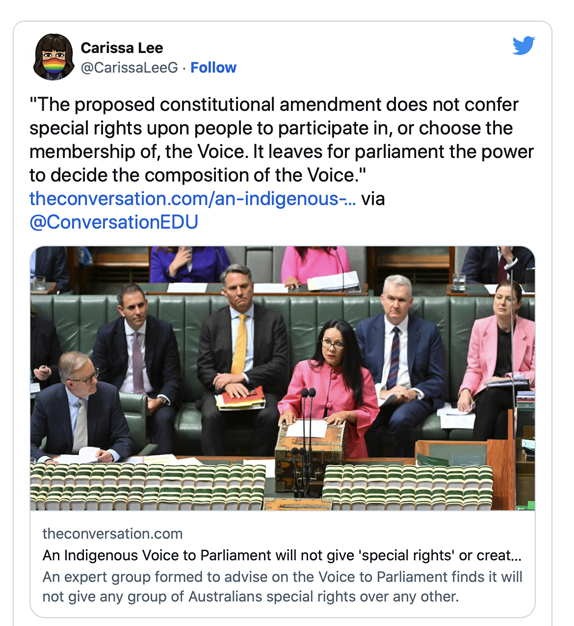Allowing the Voice to advise both the executive and parliament is the constitutionally conservative option, and the model most consistent with Australia’s current and historical constitutional practice.
Some people have criticised the draft proposal for a First Nations Voice as a radical change to Australia’s Constitution. This view is reflected in recent calls by some Liberal members of parliament for a different model that will be palatable to constitutional conservatives, and in concerns expressed by some commentators.
But this is incorrect – the current model for the Voice is constitutionally conservative. Here’s why.
Conservative or radical?
A quick reminder. The government is made up of three branches:
- the legislature (the parliament, which makes laws)
- the executive (the cabinet — the prime minister and senior ministers — and government departments, which create policy and put laws into action)
- and the judiciary (the High Court and other courts, which interpret laws).
The current draft of the constitutional amendment would allow the Voice to advise both the legislature and the executive. Proponents of this say it’s important the Voice is able to lobby both the parliament as well as cabinet ministers and government departments.
But some critics have suggested the Voice should advise parliament alone, and not the executive. That would help ensure the Voice doesn’t lead to High Court challenges, especially challenges to cabinet decisions that don’t properly consider the Voice’s advice.
The concern here is that the Voice could significantly change the country’s constitutional structure by shifting power over Aboriginal and Torres Strait Islander affairs from the executive and parliament to the judiciary.
Liberal Senator Andrew Bragg said: “No one wants a transfer of power from parliament to the High Court; we want to avoid becoming like the US.”
However, allowing the Voice to advise both the executive and parliament is the constitutionally conservative option. To put it another way, it’s the model most consistent with Australia’s current and historical constitutional practice.

A consistent change
A key feature of Australia’s constitutional system is that lawmaking is an integrated process shared by the executive and parliament. Parliament publicly debates and formally enacts legislation. The executive does most of the policy formation before laws are enacted, and most of the implementation after they’re enacted.
The executive is also responsible for making large swathes of legislation through its delegated lawmaking powers.
A model where the Voice can only advise parliament, and not also the executive, presumes a clear distinction between the two arms of government that doesn’t exist in Australia.
To minimise disruption to the existing constitutional system, the Voice needs to be structured in a way that allows it to work with the lawmaking process as it currently operates.
The current draft of the proposed text on the Voice affirms, and in fact expands, parliament’s power. It reads:
- There shall be a body, to be called the Aboriginal and Torres Strait Islander Voice.
- The Aboriginal and Torres Strait Islander Voice may make representations to parliament and the executive government on matters relating to Aboriginal and Torres Strait Islander Peoples.
- The parliament shall, subject to this Constitution, have power to make laws with respect to the composition, functions, powers and procedures of the Aboriginal and Torres Strait Islander Voice.
Parliament is the institution given the power to make laws about the Voice’s constitution. This provides parliament with the ability to adapt and develop the Voice in the future, as circumstances require. This is consistent with the role parliament performs in relation to other institutions mentioned in the Constitution.
The draft text confers no new role or powers on the High Court, which is another way in which the Voice is constitutionally conservative. It reinforces the existing centres of decision-making on Aboriginal and Torres Strait Islander affairs – the executive and parliament – by establishing a body that gives advice to these arms of government.
Possible modifications to the text designed to reduce the chance of High Court litigation could, in fact, increase the chance of litigation and possibly take power away from parliament.
What’s more, attempting to immunise the Voice completely from legal challenge would be far from constitutionally conservative. No part of the Australian Constitution has ever been entirely immune from litigation.
It’s a fundamental aspect of the rule of law in Australia that the judiciary ensures the Constitution is respected. That has been the case since federation. The current draft of the constitutional amendment reflects that fact. It leaves the judiciary to interpret the Voice’s provisions in the same way it has interpreted the Constitution’s other provisions for the past 120 years.
Possible modifications to the text designed to reduce the chance of High Court litigation could, in fact, increase the chance of litigation and possibly take power away from parliament.
Say, for example, the text is changed to state that the Voice may give advice only to parliament. What if parliament later decides it wants the Voice to give advice directly to the minister for Indigenous Australians? That choice would now give rise to the prospect of litigation and invalidation. The High Court could be asked: has parliament exceeded its constitutional powers because the text of the Constitution refers only to advice to parliament?
Even if the text is modified in other ways, separating advice given to the executive from that given to parliament would introduce a narrow distinction into the Constitution. Those types of distinctions are a common cause of High Court litigation.
For those seeking a constitutionally conservative option for the Voice, the model that aligns most closely with the existing system of government is one that allows the Voice to advise both arms of government, grants parliament broad powers to regulate the Voice, and leaves the High Court’s longstanding supervisory jurisdiction intact.![]()



